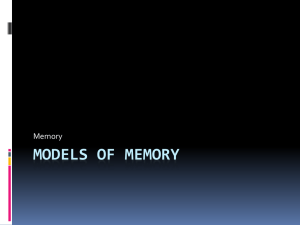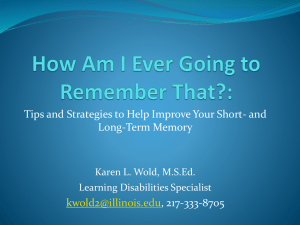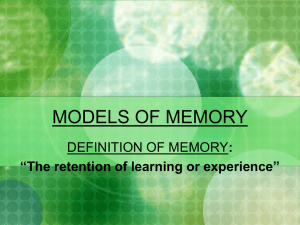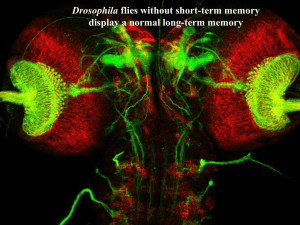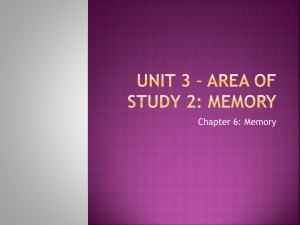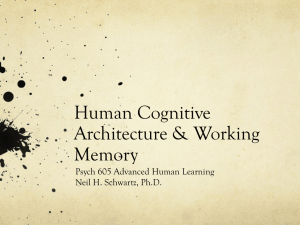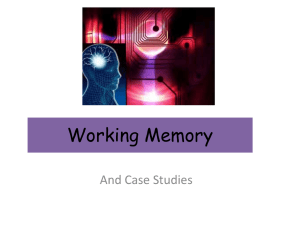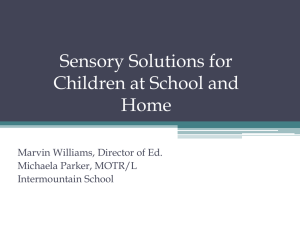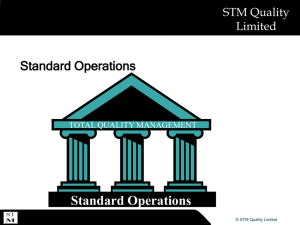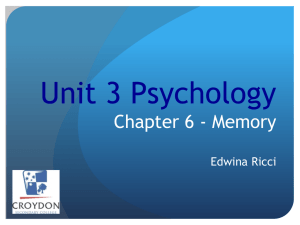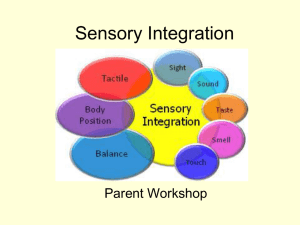1. Models of Memory - gleneaglesyear12psychology
advertisement
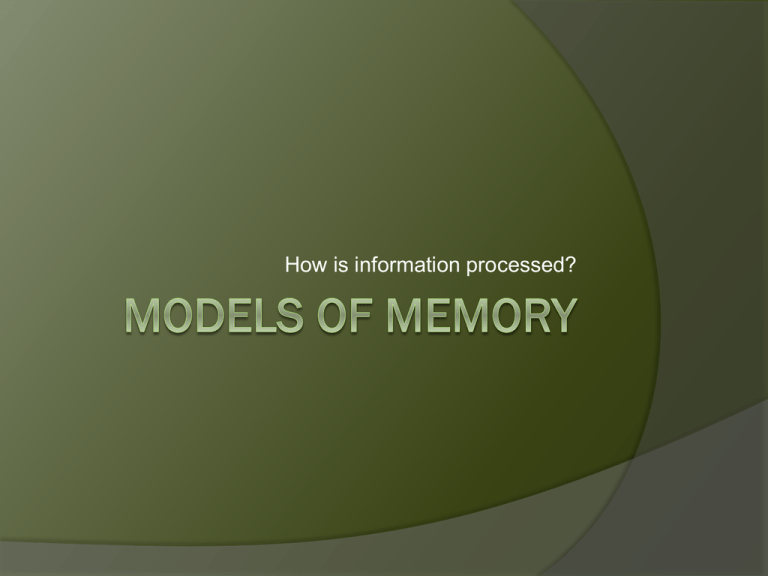
How is information processed? Memory as information processing Encoding – converting information to a useable form Storage – retaining information in memory Retrieval – information recovered from memory when needed MODELS OF MEMORY A “model” is used to represent, describe and explain memory and its components and processes. Typically models of human memory are in visual diagrams. No single model has been shown to capture all aspects of human memory. But some models of memory have been more influential than others. MODELS OF MEMORY Three models of memory will be examined in this unit of study: Atkinson and Shiffrin’s (1968) multistore model - describes memory as having 3 components Baddeley and Hitch’s (1974) model of working memory - changed views on roles and functioning of short term memory Craik and Lockhart’s (1972) levels of processing framework ○ - emphasised the importance of the “depth” at which we process information in determining how well info is stored for retrieval when needed. MODELS OF MEMORY 1960’s saw shift in assumption that memory was a single system to the idea that 2 or maybe 3 memory systems were involved. Atkinson and Shiffrin’s multi store model was so influential it was also called the “modal model” as it was representative of many similar models presented at the time. It was also known as the “stage model” as the flow of information moves through stages in the 3 components of memory. Atkinson-Shiffrin’s multi-store model of memory Info passes through 3 levels of memory as it is encoded, stored and retrieved Sensory Register – Short Term store– Long Term store Each component or store represents a place where information is held and processed. This model has structural features that do not vary , E.g. The three levels of memory Each store encodes and processes information in different ways, but they operate simultaneously and interact. Also Control processes that will differ between people, E.g. deciding what type of rehearsal to use, or what search strategy to employ ATKINSON & SHIFFRIN’S MODEL Sensory register is the entry point for all new information into memory from the external environment. Stores vast quantities of incoming visual information for up to several hundred milliseconds. Sensory info attended to is transferred to the Short Term store. If sensory info is NOT attended to it’s “memory trace” or neural imprint simply decays and disappears forever. In some cases info can bypass the STM and transfer directly to the LTM store. But Atkinson and Shiffrin did not explain how or why this occurred. Instead, they allowed for the possibility that it COULD occur. ATKINSON & SHIFFRIN’S MODEL They considered the possibility that there may be different sensory registers for different types of sensory information. e.g. Separate visual, auditory etc. The Short Term store or “temporary working memory” was described as the location where information is manipulated so that it is held to perform everyday functions. The Short Term store holds all information we are consciously aware of at any point in time. The Short Term store receives information both from the sensory registers and the Long Term store. The Short Term store has a limited capacity (unlike the sensory registers which are unlimited). It can hold up to around 7 items of information at the same time. ATKINSON & SHIFFRIN’S MODEL Information can only be held in the Short Term store for about 30 seconds unless a conscious effort is made to keep it there longer. This can be achieved through a process such as “rehearsal”. e.g. Intentionally repeating the info over and over such as remembering a phone number is a form of “rehearsal”. Actually using the information in some way is also a form of “rehearsal”. REHEARSAL Rehearsal is a “crucial” process for the Short Term store. Rehearsal enables the information to be further encoded and transferred to the Long Term store for more permanent storage. With no rehearsal, the memory trace it formed in the brain “decays” and the information is lost forever. Continual rehearsal allows the information to remain in the Short Term store as long as it is needed. Continual rehearsal “regenerates” or “renews” the information in the memory trace, thus making it a stronger memory when transferred to the Long Term store. LONG TERM STORE Holds information relatively permanently in a highly organised way and has essentially an unlimited capacity. Information in the Long Term store doesn’t usually “decay” and is stored for up to a lifetime. We can fail to retrieve information from the Long Term store. Inability to retrieve was thought by Atkinson & Shiffrin is the result of the use of ineffective search strategies to find the right memory trace for that information. The presence of related information in the Long Term store may also result in “interference” with the required information, thus disrupting the retrieval process. Atkinson-Shiffrin’s multi-store model of memory Important aspects of this model are: Structural features – permanent built in features of memory that do not vary from one situation to another. Eg. Three different stores of memory each with specific function, capacity and duration Control processes – selected by the individual and may vary across different situations. They are consciously controlled by the individual. Eg. Attention, rehearsal, retrieval (choice of search strategy) Atkinson-Shiffrin’s multi-store model of memory The model was based on extensive and substantial research findings 40 years ago but some of the underlying assumptions has since been built upon, challenged or even refuted by more recent research. E.g. 3 stage sequential flow of information is too simple E.g. Evidence for a separate sensory register for auditory info and haptic (touch) info as well as possibly for all other senses. Psychologists now refer to a “sensory memory system” STM – a number of separate interacting components not a single store Rehearsal does not guarantee retention LTM – 3 distinct sub systems, memory not retrieved but reconstructed NEW FINDINGS ON SHORT TERM STORE Atkinson & Shiffrin identified characteristics of Short Term store that still remain accurate. E.g. Storage capacity and duration, fundamental roles However we now believe Short Term store to be not a single store but a number of separate, interacting components or sub-systems that process different types of information (Baddeley, 2009) – supported by evidence from neuroimaging techniques that have matched STM and other stores with physical locations in the brain. TYPES OF REHEARSAL Psychologists now distinguish between different types of rehearsal in STM. Maintenance rehearsal (simple repitition over and over) does not guarantee transfer into LTM Elaborative rehearsal now considered to better promote encoding for long term storage. LONG TERM MEMORY Psychologists now view LTM not as a single memory component but a set of different subsystems or stores (such as episodic or procedural memory) each of which processes and stores different types of information. Retrieval from LTM is also now no longer thought to be as the info was originally stored. E.g. Memories of experiences can be “constructions” that we build or rebuild sometimes in ways that lead to distortions of memory or even “false memories”. Atkinson-Shiffrin’s multi-store model of memory Atkinson-Shiffrin’s multi-store model of memory Sensory Memory The entry area of memory, all stimuli which bombard our senses are retained in their original form for a very brief time in memory sub systems called sensory registers The info received is assumed to be the exact copy of the original i.e. “raw” sensory form rather than encoded. Stores info long enough for each sensory impression to slightly overlap the next, so we perceive the world around us as continuous rather than a series of disconnected visual images or sounds. E.g. wave pen back and forth in front of your face – an example of visual sensory memory at work. There is probably a sensory register for each sense and each retains sensory info for different periods of time. We cannot consciously manipulate info in sensory memory or extend the time period info is retained there. E.g. reading and aware of feel of watch on your wrist ICONIC MEMORY From the Greek word “icon” which means “image”. Iconic Memory: Visual sensory memory. Images only last in iconic memory for about one third (0.3) of a second. Long enough for the identification of the stimulus to begin. Activity – close eyes for one minutes, hold hand about 25 cm from face then open and close eyes – should see an image of your hand that fades away in less than a second (Ellis, 1987) e.g. movies – separate frames, sparklers in figure 8’s. U.S. Psychologist George Sperling (1960) PROVED THAT IT EXISTED! SPERLING’S RESEARCH (1960) Used a tachistoscope to briefly present participants with sets of 12 letters arranged in a pattern as shown on the next slide. The 12 letters were projected on a screen for about 1/20 of a second – this time was too brief for eye movements to occur which is why it was chosen. Participants were then required to verbally report as many letters as they saw. Sperling found that most could recall only 4 or 5 letters. With such short exposure, reporting all the letters was impossible. SPERLING’S RESEARCH (1960) However, most participants reported that for an instant they had seen ALL of the letters, but by the time they could say 4 or 5 of them the image of the remaining letters had faded. Sperling wanted to test that ALL letters were actually seen so he conducted a further experiment where he sounded a tone after a pattern of letters were flashed on the screen and found participants (once having learned the partial report system) were perfectly accurate. High, middle and low tones were used to indicate which set of letters were required to be recalled. The results then indicated that the whole pattern of 12 letters had been momentarily stored in iconic memory after the pattern left the screen. Delaying the tone longer and longer allowed Sperling to determine how quickly the images faded from iconic memory. Subsequent research by others found that the typical duration of iconic memory is about 0.2 - 0.4 seconds (Cowan, 1995). Sperling’s research PHOTOGRAPHIC MEMORY (“EIDETIC MEMORY”) Individual who are able to recall highly detailed scenes as if the actual event was occurring before them are said to have an “eidetic memory”. Eidetic memories involve eidetic images – an exact replica of a visual image that persists over time without distortion. (e.g. They literally “see” the relevant page of a textbook) Eidetic images can apparently last for prolonged periods of time (days or even weeks). Eidetic images most often occur in childhood (5% of children tested), but are less frequent in adolescence and rare in adults. (Hilgard, Atkinson & Atkinson 1979) ECHOIC MEMORY Echoic Memory – Auditory sensory memory (i.e. the brief sensory memory for incoming auditory information). Echoic sounds like echo. Echoic memory stores sounds for 3 to 4 seconds e.g. clap hands together once and see how the sound remains for a brief time and then fades away. Echoic memory functions like iconic memory but stores sounds (instead of visual images) in their original sensory form. Main difference between echoic and iconic memory is the length of time it takes information to fade. The time is long enough in echoic memory to allow the availability of auditory information to be retained so it can be selected for further processing and interpretation before the sound disappears completely. e.g. reading a novel and someone asks you a question ECHOIC MEMORY You are aware someone is speaking but since your attention is focused elsewhere you don’t immediately comprehend the message. Within a couple of seconds you say “what”? but then answer the question before it is repeated. You have retrieved this information form echoic memory Echoic memory stores the tail-end of the question temporarily while earlier parts of the question are being processed into STM. It’s possible the “what” is said just before the last parts of the message in echoic memory are transferred to STM. Important role in language comprehension, particularly in understanding speech, as speech is a blend of successively spoken sounds that are heard. When you hear a word pronounced a series of individual sounds are heard, one at a time. Word identification can only happen when all sounds of the word are heard, so auditory information needs to be stored long enough for all sounds involved to be received. It enables storage of all sounds that make a word so the word can be processed as a whole Com…. puter, Com…munism, Com….pete ECHOIC MEMORY If echoic memory was as brief as iconic memory, then speech might sound like a series of separate, distinct sounds instead of meaningful words, phrases and sentences. A typical echoic memory experiment – participant reads a story and told to ignore any spoken words they hear as they read (typically numbers e.g. 7, 2, 5) When signal sounds participant is asked to recall numbers just heard and research shows they can typically repeat accurately the last few numbers they have heard if the signal is presented immediately after the last spoken number and recall ability diminishes with increased delay between number and signal to respond up to about 10 seconds. Afterwards participants reported a vague awareness of hearing numbers spoken but after the signal they could shift their attention to the numbers and repeat them. ECHOIC MEMORY Rate of fade of information from sensory memory varies between senses. Information is lost and replaced so rapidly in the sensory registers that we are rarely aware of our capability for retaining sensory information. Sensory memory may also act as a type of filter to keep out irrelevant information that is unimportant to us and prevent cluttering the sensory stores. HAPTIC SENSORY MEMORY Haptic or tactile sensory memory is believed to involve a sensory register that retains physical sensations of touch (possibly from tensions of internal muscles) for about 1 – 2 seconds. It enables us to combine a series of touch sensations and to play a role in identifying objects we can’t see. E.g. Playing a song on guitar, sharp pencil on back of hand. DEJA VU Deja vu is French for “already seen”. Deja vu is described as the brief and intense feeling that something happening now has happened before in exactly the same way, but without you being able to recall exactly when or where. Some people believe it is evidence of psychic experiences, reincarnation or even dreams coming true but there is no scientific evidence for this. Analysis of more than 30 survey method studies (Brown, 2004) it was found that 68% of individuals reported having experience deja vu at least once in their life. He also found the incidence of deja vu decreases steadily over the lifespan. 20-24 year olds had the highest yearly experience averaging almost three per year and people in their early forties averaged less than one per year. A small minority (16%) of people claim to have one once a month. DEJA VU According to Brown (2003) a typical deja vu is triggered by some kind of visual scene and the intense feelings of familiarity last for only a few seconds. They are most common when people are fatigued or emotionally distressed, in the evening or in the company of others rather than alone. Well educated people and people who travel frequently have a higher incidence of deja vu experiences. DEJA VU Scientific explanations proposed include: Neurological possibilities – e.g. Brain malfunction Psychological explanations – e.g. Memory malfunction or inattentional blindness (not really paying attention to surroundings and when focusing attention a split second later the surroundings are perceived as suddenly and inexplicably familiar (Hockenbury & Hockenbury, 2006) Wade and Tavris (1990) explain deja vu in terms of sensory memory, suggesting it may occur when info entering sensory memory “short circuits” or fails to complete it’s normal route and must therefore be reprocessed. The familiar feeling is because you did experience the exact same situation but only a fraction of a second before, but you are also unable to determine when the initial processing occurred. Atkinson-Shiffrin’s multi-store model of memory Short Term Memory Also referred to as Working Memory – it has a limited storage capacity unless info is renewed in some way. Helps store info while you work on it In STM the information is no longer an exact replica of the sensory stimulus but an encoded (or representation) of one. Atkinson & Shiffrin model proposed information is stored in STM in verbal form such as words or numbers. Subsequent research has found that STM also stores non-verbal forms of information such as visual, spatial and auditory representations (Baddeley, Eysenck & Anderson, 2009) SHORT TERM MEMORY o o Duration: 18 – 20 seconds (recall starts to decline after about 12 seconds) Capacity: 5 – 9 pieces of information Research by Margaret and Lloyd Peterson (1959) on duration used trigrams (qlg, jfb, mwt) and a distracter (interference task) to prevent rehearsal and after a delay of between 3 to 18 seconds they were asked to recall the trigrams. By 18 seconds participants had forgotten almost all the trigrams. With no interference task (e.g. counting backwards) their performance was much better – probably due to rehearsal. CAPACITY OF SHORT TERM MEMORY US psychologist George Miller (1956) first described the limited capacity of about seven bits of information, plus or minus two for STM. Estimates of STM capacity come from research tasks requiring memory of simple lists of data of different lengths (numbers, letters, unrelated words, nonsense syllables). The length of the list that the participants can recall half the time is considered to represent the capacity of STM (Miller, 1956). Research includes using Chinese characters in non-Western cultures and the capacity is the same. (Yu et al., 1985) When info is temporarily retrieved from LTM for use in STM it fills up space in the STM. E.g. Unable to remember telephone number just looked up after thinking about what you are going to say. SHORT TERM MEMORY Information is lost though decay (fading) or displacement (being pushed out) by new info (Reitman, 1974). Forgetting what you want to say in a conversation while listening to what the other person is saying. Listening prevents rehearsal and thus the information can be lost from STM. E.g. research on calling directory assistance when operator said “have a nice day” after giving the number resulted in poorer recall of the number compared to if the operator said nothing. (Schilling & Weaver, 1983) Forgetting a name after being introduced to someone can also be explained by displacement or fading info from STM as you are engaged in conversation or noticing other aspects of the person you don’t have the chance to rehearse the new name. WORKING MEMORY “Working memory” is used to emphasise the active part of memory where info we are consciously aware of is actively “worked on” in a variety of ways. Mental processes of working memory include: Interpretation of emotions and feelings Language comprehension Daydreaming Creativity Problem solving, analysing, reasoning, planning and decision making. WORKING MEMORY Working memory provides a temporary storage facility and mental “workspace” for information currently being used in some conscious cognitive activity. (Baddeley, 1999) Besides whenever I learn something new it pushes something old out of my brain…..Remember when I took that home wine making course and I forgot how to drive. Displacement Improving STM capacity Chunking: The grouping or “packing” of separate bits of information into larger bits or units that can be remembered as single units or “chunks” of information. Chunking can increase the amount of information held in STM. Chunking expands short term memory. Chunks can be numbers, images, words, abbreviations, phrases etc. Eg. Of chunking telephone numbers. 0407 655 234 Capacity of STM is still 7, but now its 7 bits or chunks of information Improving STM Duration Rehearsal: The process of doing something so that information can be retained in STM and then retrieved when required. It can be verbal, vocal, non-verbal, sub-vocal (silently repeating in your head), mental imagery etc. TWO MAIN TYPES OF REHEARSAL Maintenance rehearsal: Involves simple, rote repetition of information being remembered over and over again so it can be retained in STM. Going over and over it! Needs to be attended to consciously – not just meaningless repetition. When the information is visual, maintenance rehearsal involves using something like an “inner eye” to maintain the image of the object or scene in STM for a period of time after you first see it. Maintenance rehearsal does NOT always lead to long-term retention. One of the limitations of maintenance rehearsal is when information is continually renewed and maintained in STM the amount of new information that can enter is restricted because of the limited storage capacity of STM. ELABORATIVE REHEARSAL Elaborative rehearsal: Involves the process of linking new information in a meaningful way with information already stored in LTM to aid in it’s storage and retrieval from LTM. More active and more effective, ensures that information is encoded well. Elaborative rehearsal is a more active and effortful process than maintenance rehearsal. It is also more effective than maintenance rehearsal for remembering new information as it helps to ensure that information is encoded well. It is a deeper level of informationprocessing. Self reference effect : Involves linking new information to personal experiences and our personal situation in some way which is meaningful to you. Levels of processing - Craik and Lockhart (1972) Dispute the distinct sub system model Fergus Craik and Robert Lockhart (1972) proposed a “conceptual framework of memory” that emphasised the important of the level at which new information is processed. They proposed that the level or depth of processing during learning determines how well it is stored in LTM Memories are best encoded, organised and stored in LTM by meaning (“semantically”). If meaning is processed during learning then LTM will be better than if meaning is not processed. More meaning – deeper processing – better storage Processing meaning is not a matter of “meaning or no meaning”. Instead there is a continuum from shallow to deep processing with levels of processing in between. Shallow encoding, basic features, repeating lists etc – bad storage Levels of processing – Craik and Lockhart (1974) Attending only to the superficial details of what is being learned and remembered would involve shallow processing. The more meaning given to new information, the deeper the level of processing. See example on p. 313 (soft, witty etc.) Levels of processing – Craik and Lockhart (1974) Considerable research evidence exists that indicates LTM is better when we process new information semantically (meaningfully). See example on p. 313 (hat, HOP, bin) See Fig. 6.23 on p. 313 Levels of processing - Craik and Lockhart – problems Levels of processing or depth are hard to define specifically and to measure There is no generally accepted means of measuring different levels of processing in valid and reliable ways (Baddeley, 1999). Despite this problem the idea of better processing and therefore better storage is supported widely by research. Suggestions for a deeper level of information processing (Hockenbury and Hockenbury, 2006) Make sure you understand the new information by restating it in your own words Actively question new information Think about the potential applications and implications of the material Relate the new material to information you already know, searching for connections that make the new information more meaningful Generate your own examples of the concept, especially examples from your own experiences. THE ABOVE MENTAL ACTIVITIES INVOLVE ELABORATIVE REHEARSAL THUS PROMOTING DEEPER PROCESSING AND ENHANCING YOUR MEMORY FOR NEW INFORMATION. See Flag example on p. 314 Alan Baddeley and Graham Hitch’s model of working memory Phonological Loop storage of verbal speech information Central Executive • Controls attention • Integrates info from the two storage sub systems • does the ‘working out’ Episodic Buffer Integrates useful LTM into what currently being worked on Pulls together streams of different info into ‘episodes’ as a meaningful whole •The seat of consciousness The workbench Visio spatial Sketchpad Storage of visual and spatial information Baddeley and Hitch’s model of working memory It describes the structure and function of working memory in terms of 3 components: 1. 2. 3. The phonological loop The visuo-spatial sketchpad The central executive The components are separate and can function relatively independently but also interact. The phonological loop and visuo-spatial sketchpad assumed to be sub-systems of working memory and the central executive is assumed to be an “attentional controller”. (Baddeley, 2009) Baddeley and Hitch’s model of working memory Baddeley and Hitch believed previous research didn’t adequately describe or explain what working memory was or how it functioned. They felt previous models of memory were more concerned with basic roles of STM (e.g. storage and role of rehearsal) rather than it’s role as a system that supports and enables complex and important cognitive activities which is what they were interested in. Example of counting doors in house – requires visual image of house (visual and spatial sub-system), counting doors verbally (using sub-system specialised for verbal information) and a need for the central executive to select the strategy to complete the task, to manage the activities of the other 2 sub-systems and to control the whole process. Phonological loop Also called “verbal working memory”. Encodes and stores auditory info Active whenever you read, listen, speak or repeat words to yourself to remember Temporarily stores a limited amount of verbal speech-like information (e.g. Phonemes – sounds of words) for a brief period of time. Assumed you hold onto the info by using sub-vocal maintenance rehearsal (repeating over and over internally like a “loop” of recording tape. Without rehearsing people can hold only about 2 seconds worth of information in their phonological memory system. Because of this people with slow speech but normal intelligence perform worse on short-term verbal memory tasks than those with speech at normal rate. Internal rehearsal is crucial to the phonological loop and without it if disrupted or eliminated then phonological storage cannot occur. Word-length effect See example on p. 317 As length of words increase, the number of words able to be remembered declines. Shorter words are easier to rehearse in the phonological loop of working memory than long multi-syllable words. (e.g. Burma and Greece easier than Afghanistan and Switzerland). Visuo-Spatial Sketchpad Also called “visual working memory”. Temporarily stores a limited amount of visual and spatial information for a brief time. Visual information is anything you can see or visualise including all features of the image. Spatial information is the visual location of objects in space. e.g. Pouring a drink on the kitchen bench or seeing a dog while jogging The visuo-spatial sketchpad is a mental workspace for storing and manipulating visual and spatial information. See example on p. 317 that requires use of the visuo-spatial sketchpad. Visuo-Spatial Sketchpad Has a limited storage capacity. The capacity of both components are independent of one another as evidenced in “dual task” experiments. E.g. Tasks that require use of visuo-spatial sketchpad and phonological loop task simultaneously. Central Executive Controls attention Integrates information from the phonological loop and visuo-spatial sketchpad as well as information retrieved from LTM; and co-ordinates the flow of information between the working memory system and LTM. Central executive is the “working” component of working memory. Central Executive It directs your attention to activities you are currently undertaking Filters essential from non-essential information Combines information from the other 2 components Selects, deletes and reorders information Add information when required from LTM to guide mental processes and behaviour. When info no longer needed, it directs its flow to LTM. Almost everything you think, feel and do in NWC is controlled and managed by the central executive. e.g. Planning, goal-setting, changing your mind about what to do. Has a limited ability to perform more than one task at a time, it can’t make numerous decisions simultaneously. Problems with the model Baddeley (2009) stated it does not explain how working memory actually links with LTM. SO.... In 2000, Baddeley added a 4th. component known as the “episodic buffer”. Episodic Buffer It is a sub-system of working memory that enables the different components of working memory to interact with LTM. Still not yet fully described. Assumed to be a limited capacity temporary storage system that holds about FOUR chunks of information. Capable of holding information in any form, thus can combine auditory info from phonological loop and visual info from visuospatial sketchpad. It also connects these sub-systems with LTM. Episodic buffer is under the control of the central executive. It is separate from LTM and has it’s own storage space and processes for storing information. Episodic Buffer Called “episodic” because this sub-system can “pull together” separate streams of information from elsewhere in working memory and from LTM, then combine them into scenes or episodes like memories of a story or a movie scene. Called it “buffer” because it provides temporary working space where information can be processed into these episodes and edited or reordered in an organised and meaningful way. A “mental workbench” for cognitive abilities. Alan Baddeley and Graham Hitch’s model of working memory Read example on pg. 319 Going to party…. - phonological loop stores the directions - Visio spatial sketchpad visualise route - Central executive directs the Episodic buffer to combine info from storage branches - Episodic buffer also adds info from LTM - Episodic buffer used as the mental ‘workbench’ to make adjustments LONG TERM MEMORY Long term memory (LTM) is the relatively permanent memory system that holds vast amounts of information for a long time, possibly indefinitely. In all models of memory, it is a different memory system that primarily interacts with STM. Where info in STM is “active”, information in LTM is “inactive” and we are not consciously aware of it unless we retrieve it. Generally STM and LTM differ in how information is retrieved, the form in which information is stored, and the way in which information is forgotten. RETRIEVAL FROM LTM We retrieve info from LTM using retrieval cues similar to call numbers on books in a library or the “find” function in computer software. Retrieval of info from LTM can be intentional or unintentional. Usually it takes only a few seconds to search through vast information in LTM to find the required information. RETRIEVAL FROM LTM Information retrieved from LTM is held in STM while it is being used. When no longer required, it can be transferred back to LTM for continued storage. Difficulty in retrieval of info from LTM is usually due to poor organisation of info during encoding and storage or failure to use an appropriate retrieval cue. If info is not properly stored, it is difficult to locate and retrieve. LTM DIFFERS FROM STM The form in which information is stored. In STM – info usually stored in terms of physical qualities of the experience (e.g. What we saw, did, heard, tasted, touched) especially sounds. In LTM – info usually stored semantically (meaning). LTM DIFFERS FROM STM The way forgetting occurs. Info stored in LTM lasts longer and is actually relatively permanent. Thus memory is not actually forgotten, but rather we are unable to retrieve it. Atkinson-Shiffrin’s multi-store model of memory Long Term Memory TWO TYPES OF LTM STORES: 1. Procedural (implicit)– Memory of how to do something, actions and skills, can be physical or intellectual (knowing how) learned by conditioning and practice. E.g. ride a bike, log onto Internet. Known as “implicit” as information can be retrieved through performance rather than intentional conscious recall or recognition. Sometimes even difficult to recall when or where we learned the actions required to do something. (e.g. daughter of florist flower arranging). Atkinson-Shiffrin’s multi-store model of memory Long Term Memory Declarative (explicit)– Memory of specific facts or events (knowing that) that can be explicitly stated or “declared”. Called explicit as it is open to intentional retrieval. E.g. name of a flower. 1. Episodic – Memory of specific life events, personal experiences, autobiographical (episodes) – often includes details of time, place, psychological state of person when event occurred. 2. Semantic – Information we have about the world. Specialised knowledge in areas of expertise, (e.g. game of chess) academic knowledge, (e.g. humans are mammals) important places, rules (“I” before “e” except after “c”) meaning of words, famous people etc. Facts that do not rely on specific time or place. Atkinson-Shiffrin’s multi-store model of memory Long Term Memory Tulving (1983) argues that semantic and episodic systems often work together in forming new memories. Thus, the memory that ultimately forms may consist of both an autobiographical episode and semantic information. EXPLICIT MEMORY Refers to the memory of information that can be consciously recalled. It is memory with awareness. E.g. Pin number of debit card. Involves a deliberate and conscious attempt to retrieve previously stored information. Tests of explicit memory are often of recall and recognition. IMPLICIT MEMORY Refers to memories that cannot be consciously recalled, but that affect behaviour and knowledge involved in performing a particular task. It is memory without awareness. (e.g. using knife and fork, writing, swimming) Testing for implicit memory usually involves some kind of cognitive task that draws on past experience, such as filling in the blank letters of a word. The task may seem unrelated to any previous learning and thus there is no conscious recall. Often referred to an “nondeclarative memories”. LANDMARK EVENTS Landmark events are key events that are significant to us and act as landmarks for our memory. (e.g. driver’s licence test, end of year formal) Landmark events can be used to search backwards and forwards through memory to locate details about other events that occurred at about the same time. They act as retrieval cues (memory prompts) for other information. ORGANISATION IN LTM Months of year example (p. 326) as evidence there is some organisation to info in LTM (Tulving, 1983). Research conducted 65 years ago participants were asked to recall items from categories learned before the experiment. They recalled them in bursts of related items, paused briefly, then recalled another group of items and so on (Bousfield & Sedgewick, 1944) See example of Bower and Clark (1969) research on LTM organisation (page 327) – boy, cap, rag, pram etc. L.A. 6.19 Semantic Network Theory Models and theories have been developed to describe and explain how the vast amount of information in LTM is stored and organised. Semantic Network Theory – first developed by US psychologist Alan Collins and computer scientist Ross Quillian in 1969. The theory emphasises organisation of information in terms of connections (“networks”) based on meaning (“semantic”). Semantic Network Theory The theory proposes that information in LTM is organised systematically (structured hierarchically) in the form of overlapping networks (“grids”) of concepts that are interconnected and interrelated by meaningful links. Each concept is called a “node” and is linked with a number of other nodes. When we search memory we start by searching a general area, we then follow the links to find the specific information we need using the interconnecting nodes. See Fig. 6.36 on p. 329 The word link game! Semantic Network Theory In reality, LTM contains 1000’s of concepts, each with very many connections. E.g. Network for animals that includes fish could overlap with network for proteins that includes fish, nuts, eggs, cheese, meat etc. This system of storing information like a filing system is highly efficient and effective in retrieving information. It minimises the duplication in storage of information due to the multiple network links. SPREADING ACTIVATION The retrieval of info from LTM begins with someone searching a particular “region” of memory and then tracing associations for links among memories (concepts) in that region, rather than randomly searching the vast information stores in LTM. In 1975, Collins published a revision of the theory with US colleague, Elizabeth Loftus. This was a less rigid version of the model and introduced the concept of spreading activation. Spreading activation proposes that activating one node during retrieval increases the likelihood that associated nodes become activated. The shorter the link between nodes in the network, the stronger the association between them and the less time it takes to activate (and retrieve) related concepts to which they are linked. Longer = weaker and therefore longer time to retrieve. The more nodes activated, the quicker the retrieval of info from LTM. SEMANTIC NETWORK THEORY AND MAPS Maps can be a useful analogy for understanding semantic network theory. Concepts are the “towns” and the links or associations are the “roads”. We store new concepts by building new roads between the towns. Thousands of towns are interconnected by kilometres of roads (links) to form a vast interconnected network. The longer the road connecting two towns the longer it takes to activate and retrieve a concept. (Schwarz & Reisberg, 1991) Semantic Network Theory Serial Position Effect: Evidence for separate STM & LTM The Serial Position Effect is a finding that free recall (recall in any order) is better for items at the end and beginning of the list than for items in the middle of the list. Recall tends to be best for items at the end and then the beginning and worst for those in the middle of the list. Retention as a U shaped curve with a strong recency effect. Primacy effect – superior recall for items at the beginning of a list Recency effect – superior recall for items at the end of a list Together with the relatively low recall of items from the middle of the list, this pattern makes up the serial position effect. SERIAL POSITION EFFECT WHY? – Items at end still in STM so remembered well because of attention and rehearsal, Items at start have been transferred to LTM. Middle items presented too late to be adequately rehearsed and transferred to LTM, too early to be held in STM without rehearsal so more likely to be forgotten (unless distinctive in some way). Serial recall is when participants are required to recall information in the order the items are presented. Serial Position Effect: Evidence for separate STM & LTM SERIAL POSITION EFFECT Study conducted by US psychologists, Glanzer and Cunitz (1966) found that recall of a list of words after a delay of 30 seconds (beyond the limits of STM) the serial position effect was not entirely observed. Recall was better at beginning of list (probably as words were transferred to LTM) and words at end of list no recency effect was evident. The serial position effect enables psychologists to identify STM and LTM as different components of memory and to describe STM and LTM as interacting in reference to their functions in memory. Findings inform TV advertisers who know that ads placed at beginning or end of a series of ads during a break are more likely to be recalled.
